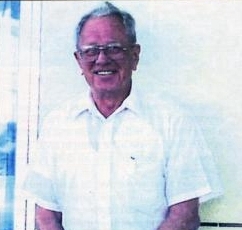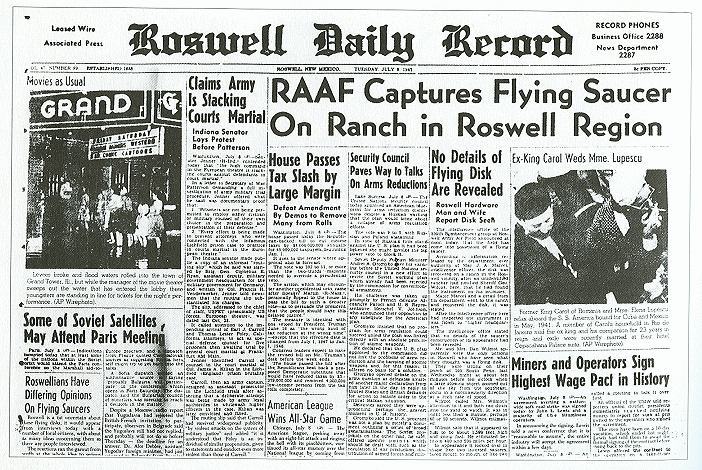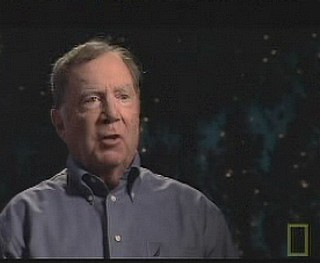At 2AM, 12 year old Jesse Marcel Jr. was awoken from his sleep by his dad prompting him to come see what he had brought in from the Foster Ranch. In the kitchen, the Marcels all had a chance to look at the mysterious debris dad was taking back to the base. Jesse Jr.’s first published recollections of this debris is that it was composed of:
…foil-like stuff, very thin, metallic-like but not metal, and very tough. There was also some structural-like material too - beams and so on. Also a quantity of black plastic material which looked organic in nature...Imprinted along the edge of some of the beam remnants there were hieroglyphic-type characters. I recently questioned my father about this, and he recalled seeing these characters also and even described them as being a pink or purplish-pink color. Egyptian hieroglyphics would be a close visual description of the characters seen, except I don't think there were any animal figures present as there are in true Egyptian hieroglyphics... (Berlitz and Moore 78-80)
In later interviews, Jesse refers to the beams as being "I-beams" because he recalls feeling and edge to the material. He also states that the figures instead of being "imprinted along the edge" (Berlitz and Moore 79) are now "embossed" (Randle and Schmitt UFO 199). If one looks back at Jesse Marcel Sr.’s descriptions, we find that such statements are not consistent with his fathers. Recall that his father stated that the beams were "three-eighths or a half inch SQUARE" (MY EMPHASIS)" and that the figures "looked like they were painted on" (Berlitz and Moore 72-73). However, Jesse clarifies what he means by embossing in the British Documentary, Incident at Roswell, "the ones I saw were not raised above the level of the beam" (Easton Online). Therefore, the figures just existed on the beams as his father and he originally stated in the book The Roswell Incident. In his affidavit, Jesse gives a full description of the material:
(6) There were three categories of debris; a thick, foil like metallic gray substance; a brittle, brownish-black plastic-like material, like Bakelite (note: an early form of plastic); and there were fragments of what appeared to be I-beams.
(7) On the inner surface of the I-beam, there appeared to be a type of writing. This writing was a purple-violet hue, and it had an embossed appearance. The figures were composed of curved, geometric shapes. It had no resemblance to Russian, Japanese or any other foreign language. It resembled hieroglyphics, but it had no animal-like characters. (Pflock Perspective162)
As for the rest of the debris, Jesse Jr. has stated, "The remainder of the debris was just described as nondescript metallic debris, or just shredded fragments" (Friedman and Berlinner 74).
The idea that Jesse Jr. had seen I-beams has been traced to Jesse Jr.'s impression that there was an edge along the beam. It seems that this is a faded memory and maybe one of the beams did have an edge after being broken. What is more important is that Jesse's father described the beams as square. Luckily, Linda Corley asked Jesse Sr. about this I-beam description prior to his death. Jesse Sr. stated, "Jesse didn't have that right to begin with....He said they looked like I-beams. But it wasn't....Let me give you a cross section of what it looked like" (Pflock Inconvenient Facts163).
Happy that he got a chance to show his family the remnants of the "crashed disc", Jesse Marcel Sr. now departs for RAAF. His arrival does not bring a lot of fanfare and it seems that nobody woke up Colonel Blanchard when Jesse came back. Instead they waited until morning to decide what to do. The base usually had a morning meeting around 9AM. For some reason the authors feel it was moved up to 7:30 AM but there is no evidence to support this. In fact, the Fort Worth Star-Telegram late edition for July 9th states, "Marcel brought back the discovery to Roswell Army Air Field early Tuesday morning and at 8 a.m. reported to his commanding officer, Col. William H. Blanchard..." (Klass What 5). Therefore, it would be hard to have the meeting at 7:30 AM if Marcel did not see Blanchard until 8 AM. Additionally, if the debris was so important that they moved the morning meeting up, why didn’t they start looking at the debris earlier when Jesse came back on base after his 2 AM pit stop at home? There is also the response by Walter Haut, who states that he was contacted at 9:30 AM in his affidavit. This implies the morning meeting occurred on schedule and that there was no undo rush to discuss it.
Randle and Schmitt seem to want to imply all sorts of sinister dealings and plotting going on at the morning meeting. However, Jesse Marcel Sr., who had to have been there never stated anything of the sort. According to Randle and Schmitt, Colonel Blanchard, in an effort to dodge any press questions, immediately took leave on the 8th in order to supervise the retrieval of the debris. However, Kal Korff reveals that Blanchard did not go on leave until the next day and the leave was planned. A telling message discovered by Robert Todd clarifies Blanchard’s leave. This message reads:
REGARDING TWX AFDOI ONE FIVE ZERO DATED SEVEN JULY COLONEL WILLIAM H BLANCHARD AND MR OLIVER LAFARGE HAVE APPOINTMENT WITH GOVERNOR MABRY FOR NINE JULY TO REQUEST HIS PROCLAIMING OF AIR FORCE DAY PD (Korff 166)
While the 7 July message was never discovered (something to be discussed later), the message makes it clear that Blanchard had planned to go on leave on 7 July before he even saw the debris brought back by Jesse Marcel. We also discover that Blanchard went on leave for three weeks for vacation as well as the signing of the Air Force day document. Clearly, anyone interested in trying to oversee the removal of the debris from the crash site would have at least stayed in the area and not have gone off into other areas of New Mexico.

Walter Haut's claim to fame is he was the base public affairs officer that July and he dealt with the press release about a recovered flying disc (Rodden 46)
With all this secrecy concerning the morning meeting, Blanchard now commits an incredible security blunder. He issues a press release! According to Walter Haut, the press information officer for RAAF, "Col. Blanchard told me to write a news release about the operation and to deliver it to both newspapers and the two radio stations in Roswell" (Pflock Perspective 156). In later years, Haut seemed confused about the actual sequence of events. He told Dava Sobel,
I don’t know whether he called me on the phone and said, "Haut, I want you to put out a press release and hand deliver it to the local news media. Here's what I want in it." Or... the adjutant might have called and said, "Haut, the old man’s got a press release he wants you to pick up and take it around town." (Sobel Online)
So, who actually wrote the press release is questionable. The authors could have included numerous people and Jesse Marcel himself may have had a hand in it’s fabrication. Even more interesting is Jesse’s description of Walter Haut as "an eager beaver PIO who took it upon himself to call the AP on this thing" (Berlitz and Moore 74). Marcel also implied that Haut jumped the gun and was not authorized to make the press release. There is evidence that the release was not even in any written form and Haut just told people over the phone. According to George Walsh of radio KSWS, Haut called him over the phone and then dictated the text to him. He never saw any formal press release and there are no copies of the actual press release in existence. All that can be determined is the following text managed to make it into the headlines of the news media:
Roswell Army Air Base, Roswell, N. M.
8 July, 1947 A.M.
The many rumors regarding the flying disc became a reality yesterday when the intelligence office of the 509th Bomb group of the Eighth Air Force, Roswell Army Air Field, was fortunate enough to gain possession of a disc through the cooperation of one of the local ranchers and the sheriffs office of Chaves County. The flying object landed on a ranch near Roswell sometime last week. Not having phone facilities, the rancher stored the disc until such time as he was able to contact the sheriff's office, who in turn notified Maj. Jesse A. Marcel of the 509th Bomb Group Intelligence Office.Action was immediately taken and the disc was picked up at the rancher's home. It was inspected at the Roswell Army Air Field and subsequently loaned by Major Marcel to higher headquarters. (Korff 27)
The newswires provided to Karl Pflock by Frank Joyce seem to confirm Walsh’s claim. The following exchange appears at 3:17PM Mountain Time:
DENVER: LETS HAVE TEXT ARMY ANNOUNCEMENT FASTEST. JUST PUT ON AS TEST AN LET ROLL IN QUOTES.
SANTE FE: ARMY GAVE VERBAL. NO TEXT. (Pflock Perspective 141)
Therefore, whatever documentation Haut may have given out was lost. The text printed was transcribed through several individuals. How correct the facts are is in question. Although the story is essentially correct, one can not be certain that what was published is how the original release was written.

The Roswell Daily Record of July 8th. (Brookesmith 148)
Even more interesting is how Frank Joyce recalls getting the news. Frank should already have been knowledgeable about the situation since he had given Wilcox the advice to call the Army. Now Haut shows up at his studio with this release and states that it was all right to broadcast the news because Blanchard had authorized the release. Shortly after broadcasting the news, Joyce states he got a call from the pentagon. In one interview, we discover that the man on the other end was a "Colonel Johnson" (Randle and Schmitt UFO 136). Nobody has ever even seem to check if a Colonel Johnson existed at the pentagon but this is who Joyce states told him to stop transmitting the story. According to Joyce, he then showed the release to Walt Whitmore Sr. (the majority owner of the radio station) to ensure that Walt knows he was authorized to broadcast the information. Joyce then goes on to state that the military showed up "clearing out every scrap of paper" (Randle and Schmitt UFO 136). Despite this, Joyce was allowed to retain the teletype transcripts that he later provided to several authors! Apparently, the military did not get EVERY scrap of paper and it is very interesting that nobody even bothered to discuss this blatant disregard for the first amendment until forty years later!
Now that Walt Whitmore is aware of the story, he decides to do a little follow-up and go get the rancher, who found the debris. He immediately drives out to get Brazel. When this happens is not clear but the earliest he could have gone out was the evening of the 7th and it may be that he went out shortly after hearing about the news release the morning of the 8th. Walt wanted to get in on the story and the best possibility would be to get Mac and talk to him live on the radio and get his comments into the newspaper. Walt’s journey would take the better part of the day and by the time he got back, his big scoop would become nothing more than a footnote.
Meanwhile, back at the base, Jesse was getting into a B-29 that was loaded with the debris. According to Jesse it was "half a B-29-ful" (Berlitz and Moore 75). However, according to Sergeant Robert Porter there was not so much debris as Major Marcel implies. Porter says in his affidavit:
(6) I was involved in loading the B-29 with the material, which was wrapped in packages with wrapping paper. One of the pieces was triangle shaped, about 2 1/2 feet across the bottom. The rest were in small packages about the size of a shoebox. The brown paper was held with tape.
(7) The material was extremely lightweight. When I picked it up, it was just like picking up an empty package. We loaded the triangle shaped package and three shoe box-sized packages into the plane. All of the packages could have fit into the trunk of a car. (Pflock Perspective 165)
Another person who saw the debris being loaded or unloaded at RAAF was Lt. Robert Shirkey. He states he had to look around Col. Blanchard to see a group of men bringing the material by. When and where this happened is confusing. Shirkey tells different versions in different books. The number of personnel change and the plane the material was taken to also changes. However, it does seem that Shirkey may have seen the material being loaded onto Marcel’s plane. He appears to contradict Porter by stating the material was unwrapped and he saw much of it in boxes as this group of soldiers hauled the debris to the plane. His descriptions may not be accurate and are based on recollections told forty years later based on what was just a quick glance. Shirkey adds in his affidavit, "All of those involved... The sergeant of the guards, all of the crewman, and myself ... were shipped out to different bases within two weeks" (Pflock Perspective 171). This sounds very sinister but at the last minute, Shirkey pens in at the bottom that he was "…aware of several people being shipped out…" but it appears that these transfers were routine (Pflock Perspective 171). Confirming this is the fact that Robert Porter was not shipped out at all and when the USAF investigated these claims they could not find any evidence of such transfers:
The history and the morning reports also showed that the subsequent activities at Roswell during the month were mostly mundane and not indicative of any unusual high level activity, expenditure of manpower, resources, or security. (HQ USAF 20)
The events described are very complex but one can get a general idea of what happened. Jesse arrived home early on the 8th at 2AM as everyone has described. The morning meeting probably happened at 9AM since Haut was told at 9:30 AM to issue the press release and Marcel did not first see Blanchard until 8AM. Haut probably wrote the press release and he definitely called the news media. He might have gotten help from Jesse Marcel in the details but this is not clear. After the news media revealed the story, General McMullen called Colonel Dubose at Fort Worth inquiring about the events. Colonel Dubose directed Colonel Blanchard to fly the material to him and General Ramey for them to examine. Jesse and Blanchard, based on these orders, supervised the hasty loading of a B-29 with the debris for a flight to Fort Worth. Robert Porter definitely loaded it into the plane and Lt. Shirkey may have seen additional debris being carried out to the plane. By mid-afternoon, the plane was on it’s way to Fort Worth and Jesse Marcel Sr. was on board. Meanwhile, wishing to get the best lead on the story, Walt Whitmore Sr. is on his way out to the ranch to get Mac Brazel. All these events were about to come together as part of the famous crashed saucer legend.
